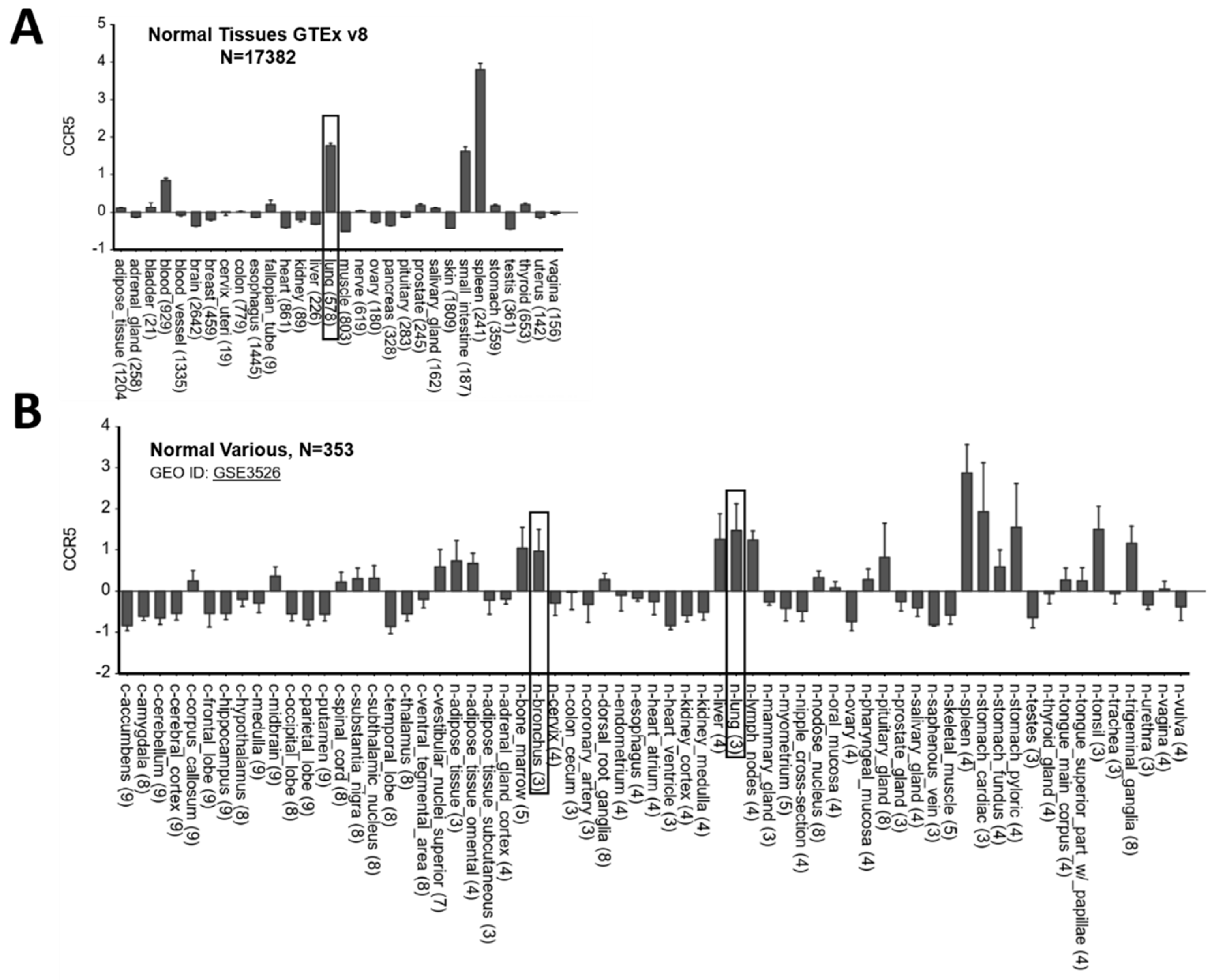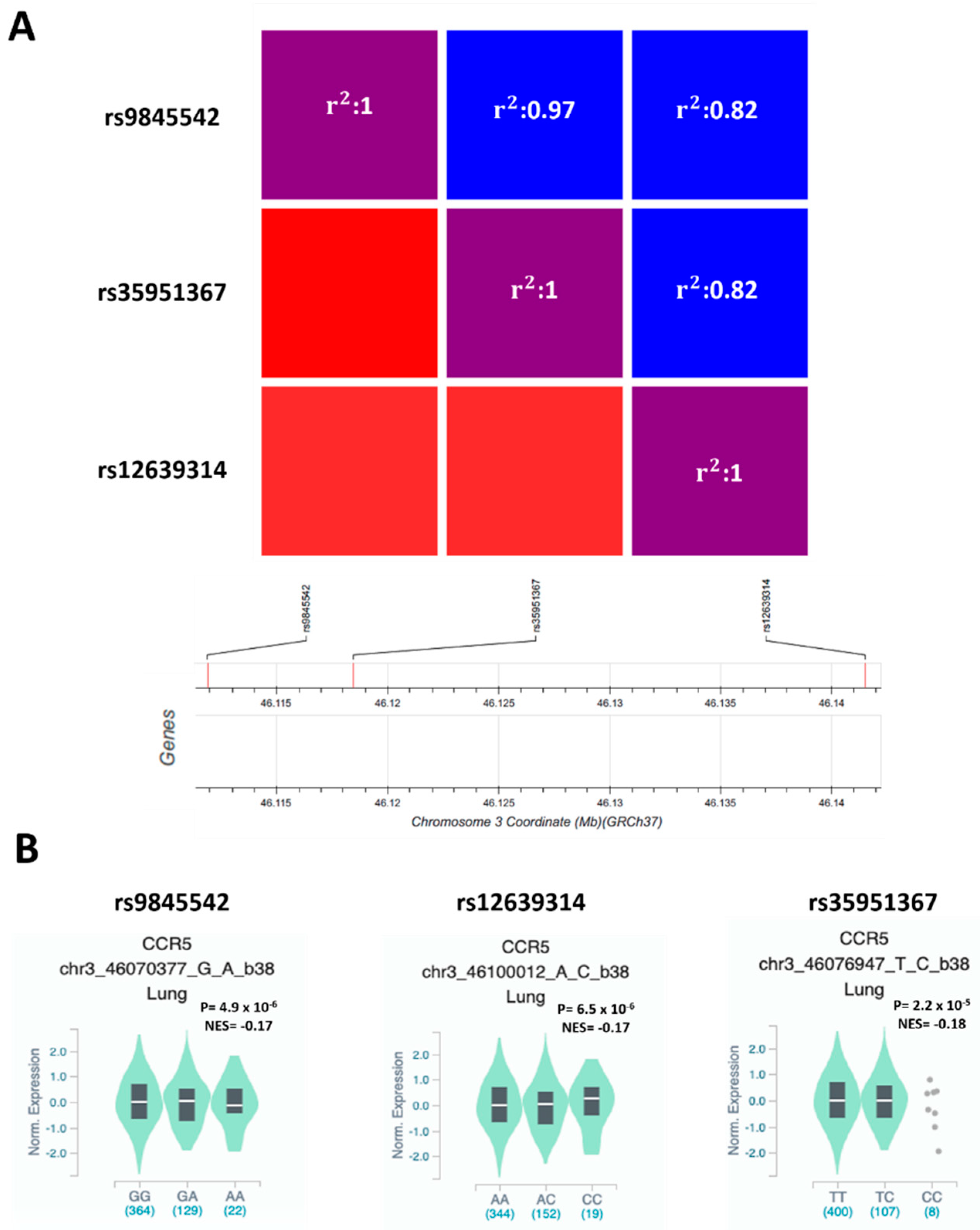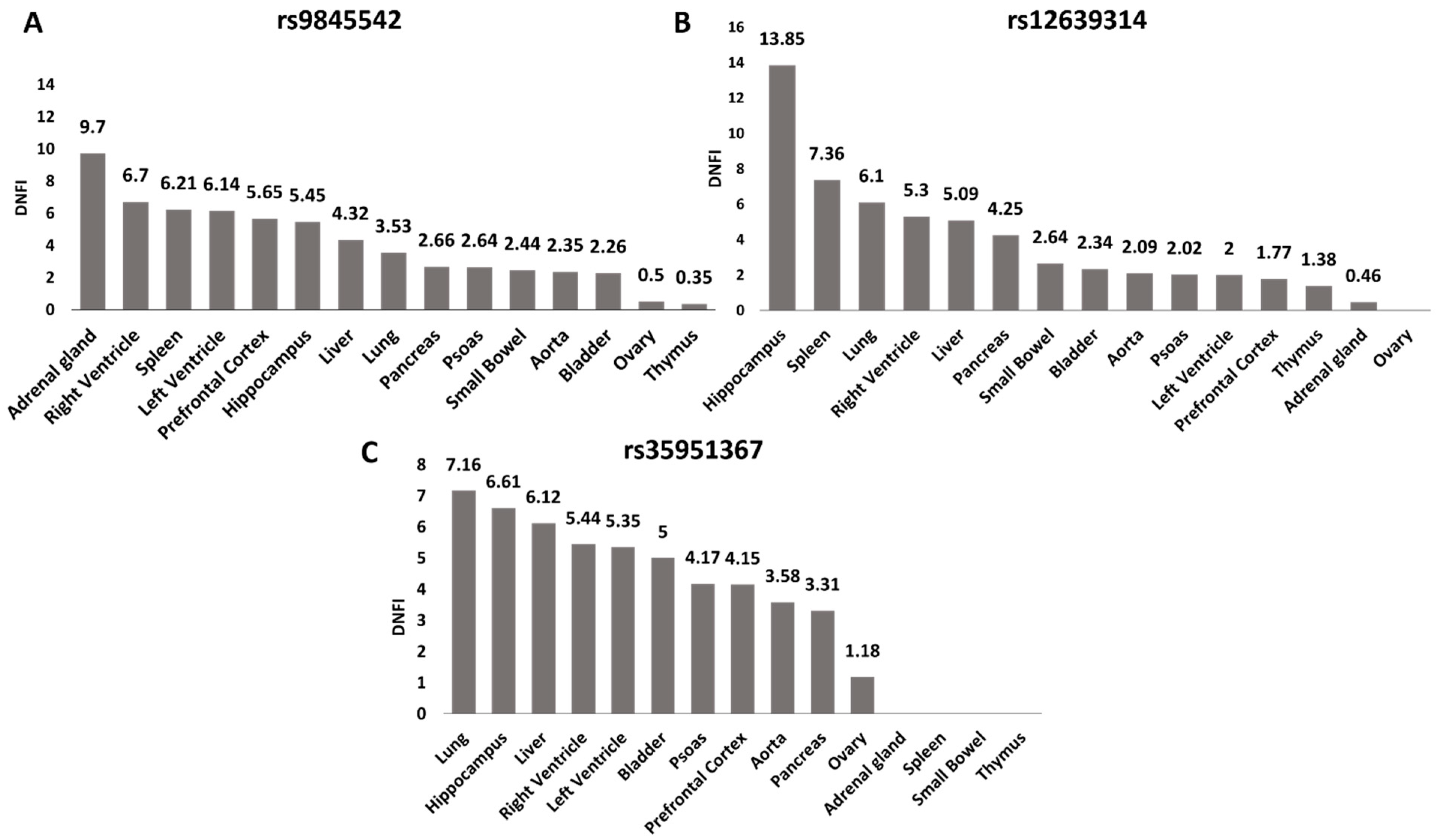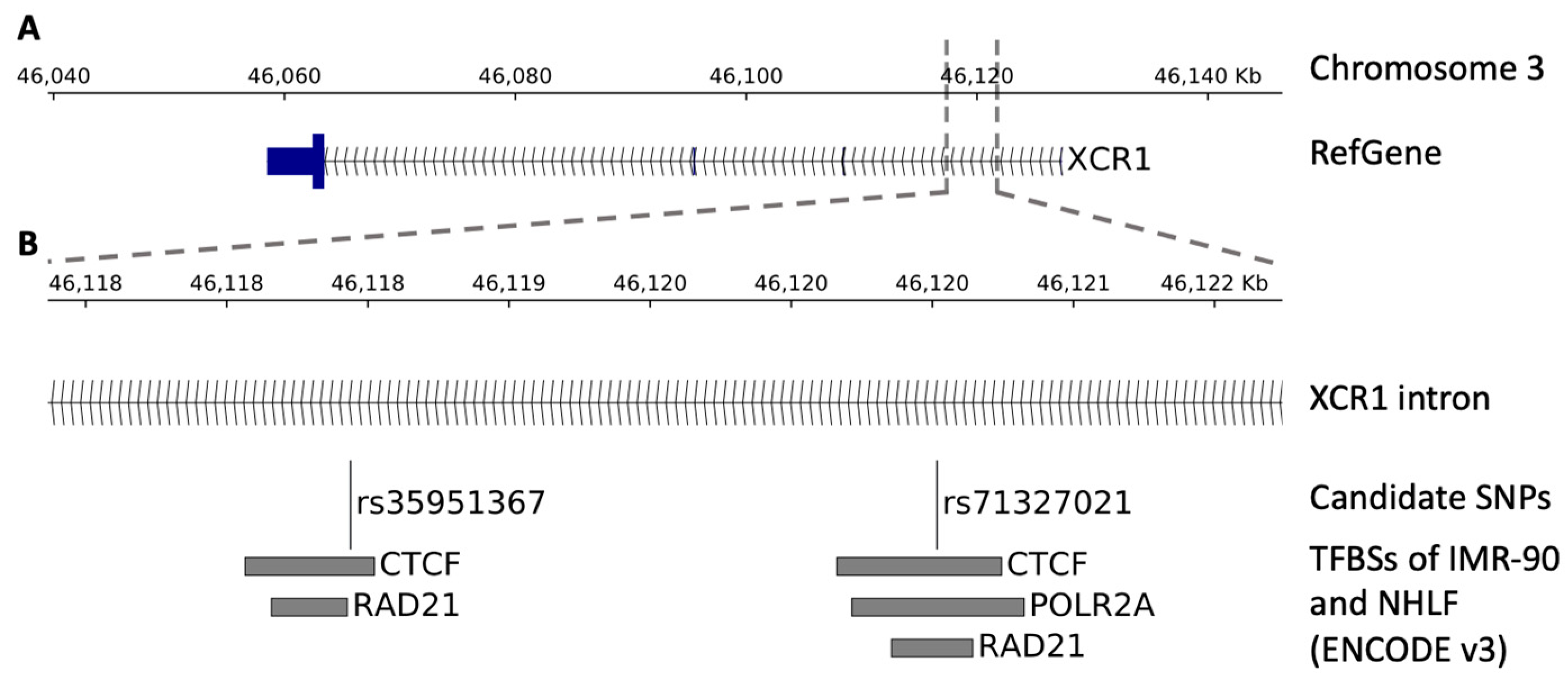Regulatory Noncoding and Predicted Pathogenic Coding Variants of CCR5 Predispose to Severe COVID-19
Abstract
1. Introduction
2. Results
2.1. CCR5 Is Highly Expressed in Lung and Bronchus
2.2. CCR5 Expression Is Affected by SNPs at Chromosome Risk Locus 3p21.31
2.3. Replication Studies
2.4. Coding Variants in CCR5
3. Discussion
4. Materials and Methods
4.1. GWAS Data
4.2. Replication Study of rs35951367 SNP
4.3. In Silico Analysis
4.4. Whole Exome Sequencing
4.5. Bioinformatic Analysis of Sequencing Data
4.6. Association Study of the Coding Rare Variant rs34418657
Supplementary Materials
Author Contributions
Funding
Institutional Review Board Statement
Informed Consent Statement
Data Availability Statement
Acknowledgments
Conflicts of Interest
References
- Baloch, S.; Baloch, M.A.; Zheng, T.; Pei, X. The Coronavirus Disease 2019 (COVID-19) Pandemic. Tohoku J. Exp. Med. 2020, 250, 271–278. [Google Scholar] [CrossRef] [PubMed]
- Berlin, D.A.; Gulick, R.M.; Martinez, F.J. Severe Covid-19. N. Engl. J. Med. 2020, 383, 2451–2460. [Google Scholar] [CrossRef] [PubMed]
- Bhatraju, P.K.; Ghassemieh, B.J.; Nichols, M.; Kim, R.; Jerome, K.R.; Nalla, A.K.; Greninger, A.L.; Pipavath, S.; Wurfel, M.M.; Evans, L.; et al. Covid-19 in Critically Ill Patients in the Seattle Region—Case Series. N. Engl. J. Med. 2020, 382, 2012–2022. [Google Scholar] [CrossRef] [PubMed]
- Zheng, Z.; Peng, F.; Xu, B.; Zhao, J.; Liu, H.; Peng, J.; Li, Q.; Jiang, C.; Zhou, Y.; Liu, S.; et al. Risk factors of critical & mortal COVID-19 cases: A systematic literature review and meta-analysis. J. Infect. 2020, 81, e16–e25. [Google Scholar] [CrossRef] [PubMed]
- Zhou, F.; Yu, T.; Du, R.; Fan, G.; Liu, Y.; Liu, Z.; Xiang, J.; Wang, Y.; Song, B.; Gu, X.; et al. Clinical course and risk factors for mortality of adult inpatients with COVID-19 in Wuhan, China: A retrospective cohort study. Lancet 2020, 395, 1054–1062. [Google Scholar] [CrossRef]
- Ellinghaus, D.; Degenhardt, F.; Bujanda, L.; Buti, M.; Albillos, A.; Invernizzi, P.; Fernandez, J.; Prati, D.; Baselli, G.; Asselta, R.; et al. Genomewide Association Study of Severe Covid-19 with Respiratory Failure. N. Engl. J. Med. 2020, 383, 1522–1534. [Google Scholar] [CrossRef] [PubMed]
- Pairo-Castineira, E.; Clohisey, S.; Klaric, L.; Bretherick, A.D.; Rawlik, K.; Pasko, D.; Walker, S.; Parkinson, N.; Fourman, M.H.; Russell, C.D.; et al. Genetic mechanisms of critical illness in COVID-19. Nature 2021, 591, 92–98. [Google Scholar] [CrossRef] [PubMed]
- Zhang, Q.; Bastard, P.; Liu, Z.; Le Pen, J.; Moncada-Velez, M.; Chen, J.; Ogishi, M.; Sabli, I.K.D.; Hodeib, S.; Korol, C.; et al. Inborn errors of type I IFN immunity in patients with life-threatening COVID-19. Science 2020, 370. [Google Scholar] [CrossRef] [PubMed]
- Freedman, M.L.; Monteiro, A.N.; Gayther, S.A.; Coetzee, G.A.; Risch, A.; Plass, C.; Casey, G.; De Biasi, M.; Carlson, C.; Duggan, D.; et al. Principles for the post-GWAS functional characterization of cancer risk loci. Nat. Genet. 2011, 43, 513–518. [Google Scholar] [CrossRef] [PubMed]
- Gornalusse, G.G.; Mummidi, S.; Gaitan, A.A.; Jimenez, F.; Ramsuran, V.; Picton, A.; Rogers, K.; Manoharan, M.S.; Avadhanam, N.; Murthy, K.K.; et al. Epigenetic mechanisms, T-cell activation, and CCR5 genetics interact to regulate T-cell expression of CCR5, the major HIV-1 coreceptor. Proc. Natl. Acad. Sci. USA 2015, 112, E4762–E4771. [Google Scholar] [CrossRef]
- Bleul, C.C.; Wu, L.; Hoxie, J.A.; Springer, T.A.; Mackay, C.R. The HIV coreceptors CXCR4 and CCR5 are differentially expressed and regulated on human T lymphocytes. Proc. Natl. Acad. Sci. USA 1997, 94, 1925–1930. [Google Scholar] [CrossRef] [PubMed]
- Shaheen, Z.R.; Christmann, B.S.; Stafford, J.D.; Moran, J.M.; Buller, R.M.L.; Corbett, J.A. CCR5 is a required signaling receptor for macrophage expression of inflammatory genes in response to viral double-stranded RNA. Am. J. Physiol. Regul. Integr. Comp. Physiol. 2019, 316, R525–R534. [Google Scholar] [CrossRef] [PubMed]
- Solloch, U.V.; Lang, K.; Lange, V.; Bohme, I.; Schmidt, A.H.; Sauter, J. Frequencies of gene variant CCR5-Delta32 in 87 countries based on next-generation sequencing of 1.3 million individuals sampled from 3 national DKMS donor centers. Hum. Immunol. 2017, 78, 710–717. [Google Scholar] [CrossRef] [PubMed]
- Huang, Y.; Paxton, W.A.; Wolinsky, S.M.; Neumann, A.U.; Zhang, L.; He, T.; Kang, S.; Ceradini, D.; Jin, Z.; Yazdanbakhsh, K.; et al. The role of a mutant CCR5 allele in HIV-1 transmission and disease progression. Nat. Med. 1996, 2, 1240–1243. [Google Scholar] [CrossRef]
- Ni, J.; Wang, D.; Wang, S. The CCR5-Delta32 Genetic Polymorphism and HIV-1 Infection Susceptibility: A Meta-analysis. Open Med. (Wars.) 2018, 13, 467–474. [Google Scholar] [CrossRef] [PubMed]
- Woollard, S.M.; Kanmogne, G.D. Maraviroc: A review of its use in HIV infection and beyond. Drug Des. Dev. Ther. 2015, 9, 5447–5468. [Google Scholar] [CrossRef]
- Algood, H.M.; Flynn, J.L. CCR5-deficient mice control Mycobacterium tuberculosis infection despite increased pulmonary lymphocytic infiltration. J. Immunol. 2004, 173, 3287–3296. [Google Scholar] [CrossRef]
- Dawson, T.C.; Beck, M.A.; Kuziel, W.A.; Henderson, F.; Maeda, N. Contrasting effects of CCR5 and CCR2 deficiency in the pulmonary inflammatory response to influenza A virus. Am. J. Pathol. 2000, 156, 1951–1959. [Google Scholar] [CrossRef]
- Roth, R.B.; Hevezi, P.; Lee, J.; Willhite, D.; Lechner, S.M.; Foster, A.C.; Zlotnik, A. Gene expression analyses reveal molecular relationships among 20 regions of the human CNS. Neurogenetics 2006, 7, 67–80. [Google Scholar] [CrossRef]
- Yang, D.; Jang, I.; Choi, J.; Kim, M.S.; Lee, A.J.; Kim, H.; Eom, J.; Kim, D.; Jung, I.; Lee, B. 3DIV: A 3D-genome Interaction Viewer and database. Nucleic Acids Res. 2018, 46, D52–D57. [Google Scholar] [CrossRef]
- Shelton, J.F.; Shastri, A.J.; Ye, C.; Weldon, C.H.; Filshtein-Sonmez, T.; Coker, D.; Symons, A.; Esparza-Gordillo, J.; The 23andMe COVID-19 Team; Aslibekyan, S.; et al. Trans-ancestry analysis reveals genetic and nongenetic associations with COVID-19 susceptibility and severity. Nat. Genet. 2021. [Google Scholar] [CrossRef] [PubMed]
- Pires, D.E.; Ascher, D.B.; Blundell, T.L. DUET: A server for predicting effects of mutations on protein stability using an integrated computational approach. Nucleic Acids Res. 2014, 42, W314–W319. [Google Scholar] [CrossRef] [PubMed]
- Daga, S.; Fallerini, C.; Baldassarri, M.; Fava, F.; Valentino, F.; Doddato, G.; Benetti, E.; Furini, S.; Giliberti, A.; Tita, R.; et al. Employing a systematic approach to biobanking and analyzing clinical and genetic data for advancing COVID-19 research. Eur. J. Hum. Genet. 2021. [Google Scholar] [CrossRef] [PubMed]
- LoPresti, M.; Beck, D.B.; Duggal, P.; Cummings, D.A.T.; Solomon, B.D. The Role of Host Genetic Factors in Coronavirus Susceptibility: Review of Animal and Systematic Review of Human Literature. Am. J. Hum. Genet. 2020, 107, 381–402. [Google Scholar] [CrossRef] [PubMed]
- Russo, R.; Andolfo, I.; Lasorsa, V.A.; Iolascon, A.; Capasso, M. Genetic Analysis of the Coronavirus SARS-CoV-2 Host Protease TMPRSS2 in Different Populations. Front. Genet. 2020, 11, 872. [Google Scholar] [CrossRef]
- Andolfo, I.; Russo, R.; Lasorsa, A.V.; Cantalupo, S.; Rosato, B.E.; Bonfiglio, F.; Frisso, G.; Pasquale, A.; Cassese, G.M.; Servillo, G.; et al. Common variants at 21q22.3 locus influence MX1 gene expression and susceptibility to severe COVID-19. medRxiv 2020, 24, 102322. [Google Scholar] [CrossRef]
- Lawhorn, C.; Yuferov, V.; Randesi, M.; Ho, A.; Morgello, S.; Kreek, M.J.; Levran, O. Genetic diversity and linkage disequilibrium in the chemokine receptor CCR2-CCR5 region among individuals and populations. Cytokine 2013, 64, 571–576. [Google Scholar] [CrossRef][Green Version]
- Trecarichi, E.M.; Tumbarello, M.; de Gaetano Donati, K.; Tamburrini, E.; Cauda, R.; Brahe, C.; Tiziano, F.D. Partial protective effect of CCR5-Delta 32 heterozygosity in a cohort of heterosexual Italian HIV-1 exposed uninfected individuals. AIDS Res. Ther. 2006, 3, 22. [Google Scholar] [CrossRef] [PubMed]
- Brelot, A.; Chakrabarti, L.A. CCR5 Revisited: How Mechanisms of HIV Entry Govern AIDS Pathogenesis. J. Mol. Biol. 2018, 430, 2557–2589. [Google Scholar] [CrossRef] [PubMed]
- Zeberg, H.; Paabo, S. The major genetic risk factor for severe COVID-19 is inherited from Neanderthals. Nature 2020, 587, 610–612. [Google Scholar] [CrossRef] [PubMed]
- Hoover, K.C. Intragenus (Homo) variation in a chemokine receptor gene (CCR5). PLoS ONE 2018, 13, e0204989. [Google Scholar] [CrossRef] [PubMed]
- Kunkel, E.J.; Boisvert, J.; Murphy, K.; Vierra, M.A.; Genovese, M.C.; Wardlaw, A.J.; Greenberg, H.B.; Hodge, M.R.; Wu, L.; Butcher, E.C.; et al. Expression of the chemokine receptors CCR4, CCR5, and CXCR3 by human tissue-infiltrating lymphocytes. Am. J. Pathol. 2002, 160, 347–355. [Google Scholar] [CrossRef]
- Glass, W.G.; Lim, J.K.; Cholera, R.; Pletnev, A.G.; Gao, J.L.; Murphy, P.M. Chemokine receptor CCR5 promotes leukocyte trafficking to the brain and survival in West Nile virus infection. J. Exp. Med. 2005, 202, 1087–1098. [Google Scholar] [CrossRef] [PubMed]
- Kohlmeier, J.E.; Miller, S.C.; Smith, J.; Lu, B.; Gerard, C.; Cookenham, T.; Roberts, A.D.; Woodland, D.L. The chemokine receptor CCR5 plays a key role in the early memory CD8+ T cell response to respiratory virus infections. Immunity 2008, 29, 101–113. [Google Scholar] [CrossRef] [PubMed]
- Eitner, F.; Cui, Y.; Hudkins, K.L.; Anderson, D.M.; Schmidt, A.; Morton, W.R.; Alpers, C.E. Chemokine receptor (CCR5) expression in human kidneys and in the HIV infected macaque. Kidney Int. 1998, 54, 1945–1954. [Google Scholar] [CrossRef] [PubMed]
- Dorf, M.E.; Berman, M.A.; Tanabe, S.; Heesen, M.; Luo, Y. Astrocytes express functional chemokine receptors. J. Neuroimmunol. 2000, 111, 109–121. [Google Scholar] [CrossRef]
- Singh, S.K.; Mishra, M.K.; Eltoum, I.A.; Bae, S.; Lillard, J.W., Jr.; Singh, R. CCR5/CCL5 axis interaction promotes migratory and invasiveness of pancreatic cancer cells. Sci. Rep. 2018, 8, 1323. [Google Scholar] [CrossRef] [PubMed]
- Simpson, J.; Rezaie, P.; Newcombe, J.; Cuzner, M.L.; Male, D.; Woodroofe, M.N. Expression of the beta-chemokine receptors CCR2, CCR3 and CCR5 in multiple sclerosis central nervous system tissue. J. Neuroimmunol. 2000, 108, 192–200. [Google Scholar] [CrossRef]
- Pathak, G.A.; Singh, K.; Miller-Fleming, T.W.; Wendt, F.; Ehsan, N.; Hou, K.; Johnson, R.; Lu, Z.; Gopalan, S.; Dimbou, L.Y.; et al. Integrative analyses identify susceptibility genes underlying COVID-19 hospitalization. medRxiv 2020. [Google Scholar] [CrossRef]
- Kim, S.; Yu, N.K.; Kaang, B.K. CTCF as a multifunctional protein in genome regulation and gene expression. Exp. Mol. Med. 2015, 47, e166. [Google Scholar] [CrossRef]
- Phillips, J.E.; Corces, V.G. CTCF: Master weaver of the genome. Cell 2009, 137, 1194–1211. [Google Scholar] [CrossRef] [PubMed]
- Mehlotra, R.K. Chemokine receptor gene polymorphisms and COVID-19: Could knowledge gained from HIV/AIDS be important? Infect. Genet. Evol. 2020, 85, 104512. [Google Scholar] [CrossRef] [PubMed]
- McDermott, D.H.; Zimmerman, P.A.; Guignard, F.; Kleeberger, C.A.; Leitman, S.F.; Murphy, P.M. CCR5 promoter polymorphism and HIV-1 disease progression. Multicenter AIDS Cohort Study (MACS). Lancet 1998, 352, 866–870. [Google Scholar] [CrossRef]
- Kulkarni, S.; Lied, A.; Kulkarni, V.; Rucevic, M.; Martin, M.P.; Walker-Sperling, V.; Anderson, S.K.; Ewy, R.; Singh, S.; Nguyen, H.; et al. CCR5AS lncRNA variation differentially regulates CCR5, influencing HIV disease outcome. Nat. Immunol. 2019, 20, 824–834. [Google Scholar] [CrossRef] [PubMed]
- Glass, W.G.; McDermott, D.H.; Lim, J.K.; Lekhong, S.; Yu, S.F.; Frank, W.A.; Pape, J.; Cheshier, R.C.; Murphy, P.M. CCR5 deficiency increases risk of symptomatic West Nile virus infection. J. Exp. Med. 2006, 203, 35–40. [Google Scholar] [CrossRef] [PubMed]
- Durrant, D.M.; Daniels, B.P.; Pasieka, T.; Dorsey, D.; Klein, R.S. CCR5 limits cortical viral loads during West Nile virus infection of the central nervous system. J. Neuroinflammation 2015, 12, 233. [Google Scholar] [CrossRef] [PubMed]
- Falcon, A.; Cuevas, M.T.; Rodriguez-Frandsen, A.; Reyes, N.; Pozo, F.; Moreno, S.; Ledesma, J.; Martinez-Alarcon, J.; Nieto, A.; Casas, I. CCR5 deficiency predisposes to fatal outcome in influenza virus infection. J. Gen. Virol. 2015, 96, 2074–2078. [Google Scholar] [CrossRef] [PubMed]
- Laing, A.G.; Lorenc, A.; Del Molino Del Barrio, I.; Das, A.; Fish, M.; Monin, L.; Munoz-Ruiz, M.; McKenzie, D.R.; Hayday, T.S.; Francos-Quijorna, I.; et al. A dynamic COVID-19 immune signature includes associations with poor prognosis. Nat. Med. 2020, 26, 1623–1635. [Google Scholar] [CrossRef] [PubMed]
- Sharif, F.A.; Ashour, M.J.; Badawi, N.T.; Al-Ashi, S.F. Polymorphism in Regulatory T-cell (Treg)-Related Genes Is Associated with Unexplained Recurrent Pregnancy Loss. Am. J. Clin. Exp. Med. 2016, 4, 63–67. [Google Scholar] [CrossRef][Green Version]
- Samson, M.; Libert, F.; Doranz, B.J.; Rucker, J.; Liesnard, C.; Farber, C.M.; Saragosti, S.; Lapoumeroulie, C.; Cognaux, J.; Forceille, C.; et al. Resistance to HIV-1 infection in caucasian individuals bearing mutant alleles of the CCR-5 chemokine receptor gene. Nature 1996, 382, 722–725. [Google Scholar] [CrossRef] [PubMed]
- Initiative, C.-H.G. The COVID-19 Host Genetics Initiative, a global initiative to elucidate the role of host genetic factors in susceptibility and severity of the SARS-CoV-2 virus pandemic. Eur. J. Hum. Genet. 2020, 28, 715–718. [Google Scholar] [CrossRef] [PubMed]




| Italian Cases n = 202 | Italian Controls n = 929 | P | OR (CI: 95%) | |||
|---|---|---|---|---|---|---|
| rs35951367 | n | % | n | % | ||
| Genotype | ||||||
| TT | 120 | 59 | 625 | 67 | - | |
| TC | 72 | 36 | 266 | 29 | 0.038 | 1.410 (1.018–1.952) |
| CC | 10 | 5 | 38 | 4 | 0.39 | 1.371 (0.665–2.826) |
| Allele | ||||||
| T | 312 | 77 | 1516 | 82 | - | |
| C | 92 | 23 | 342 | 18 | 0.043 | 1.307 (1.007–1.696) |
| Dominant | ||||||
| TT/TC | 192 | 95 | 891 | 96 | - | |
| CC | 10 | 5 | 38 | 4 | 0.39 | 1.371 (0.665–2.826) |
| Recessive | ||||||
| TT | 120 | 59 | 625 | 67 | - | |
| TC/CC | 82 | 41 | 304 | 33 | 0.032 | 1.405 (1.028–1.920) |
| Sample ID | Chr Position (hg19) | Ref | Alt | Func. Ref Gene | AA Change (CCR5: NM_000579) | SNP | CADD |
|---|---|---|---|---|---|---|---|
| R- 16 | chr3:46415061 | G | A | nonsynonymous SNV | exon3: c. G668A: p. R223Q | rs1800452 | 22.5 |
| R- 68 | chr3:46414611 | C | T | nonsynonymous SNV | exon3: c. C218T: p. A73V | rs56198941 | 31 |
| R- 135 | chr3:46415073-46415075 | AGA | - | nonframeshift deletion | exon3: c. 680_682del: p. K229del | rs774845977 | / |
| R- 30 | chr3:46414784 | G | T | nonsynonymous SNV | exon3: c. G391T: p. V131F | rs34418657 | 29.8 |
| R- 60 | chr3:46414784 | G | T | nonsynonymous SNV | exon3: c. G391T: p. V131F | rs34418657 | 29.8 |
| R- 72 | chr3:46414784 | G | T | nonsynonymous SNV | exon3: c. G391T: p. V131F | rs34418657 | 29.8 |
| Italian Cases n = 221 | Italian Controls n = 1084 | P | OR (CI: 95%) | |||
|---|---|---|---|---|---|---|
| rs34418657 | n | % | n | % | ||
| Genotype | ||||||
| GG | 217 | 98 | 1079 | 99.5 | - | |
| GT | 4 | 2 | 5 | 0.5 | 0.027 | 3.978 (1.060–14.933) |
| TT | 0 | - | 0 | - | ||
| Allele | ||||||
| G | 438 | 99 | 2163 | 99.8 | - | |
| T | 4 | 1 | 5 | 0.2 | 0.116 | 3.951 (1.057–14.771) |
| Recessive | ||||||
| GG | 217 | 98.2 | 1079 | 99.5 | - | |
| GT/TT | 4 | 1.8 | 5 | 0.5 | 0.027 | 3.978 (1.060–14.933) |
Publisher’s Note: MDPI stays neutral with regard to jurisdictional claims in published maps and institutional affiliations. |
© 2021 by the authors. Licensee MDPI, Basel, Switzerland. This article is an open access article distributed under the terms and conditions of the Creative Commons Attribution (CC BY) license (https://creativecommons.org/licenses/by/4.0/).
Share and Cite
Cantalupo, S.; Lasorsa, V.A.; Russo, R.; Andolfo, I.; D’Alterio, G.; Rosato, B.E.; Frisso, G.; Abete, P.; Cassese, G.M.; Servillo, G.; et al. Regulatory Noncoding and Predicted Pathogenic Coding Variants of CCR5 Predispose to Severe COVID-19. Int. J. Mol. Sci. 2021, 22, 5372. https://doi.org/10.3390/ijms22105372
Cantalupo S, Lasorsa VA, Russo R, Andolfo I, D’Alterio G, Rosato BE, Frisso G, Abete P, Cassese GM, Servillo G, et al. Regulatory Noncoding and Predicted Pathogenic Coding Variants of CCR5 Predispose to Severe COVID-19. International Journal of Molecular Sciences. 2021; 22(10):5372. https://doi.org/10.3390/ijms22105372
Chicago/Turabian StyleCantalupo, Sueva, Vito Alessandro Lasorsa, Roberta Russo, Immacolata Andolfo, Giuseppe D’Alterio, Barbara Eleni Rosato, Giulia Frisso, Pasquale Abete, Gian Marco Cassese, Giuseppe Servillo, and et al. 2021. "Regulatory Noncoding and Predicted Pathogenic Coding Variants of CCR5 Predispose to Severe COVID-19" International Journal of Molecular Sciences 22, no. 10: 5372. https://doi.org/10.3390/ijms22105372
APA StyleCantalupo, S., Lasorsa, V. A., Russo, R., Andolfo, I., D’Alterio, G., Rosato, B. E., Frisso, G., Abete, P., Cassese, G. M., Servillo, G., Gentile, I., Piscopo, C., Della Monica, M., Fiorentino, G., Russo, G., Cerino, P., Buonerba, C., Pierri, B., Zollo, M., ... Capasso, M. (2021). Regulatory Noncoding and Predicted Pathogenic Coding Variants of CCR5 Predispose to Severe COVID-19. International Journal of Molecular Sciences, 22(10), 5372. https://doi.org/10.3390/ijms22105372











